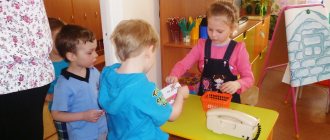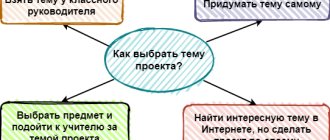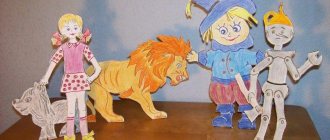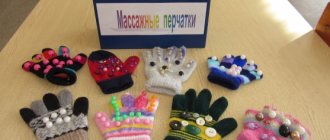Consultation for teachers “Five-minute speech therapy sessions in the work of a teacher”
Author: Trotsenko Tatyana Petrovna
Consultation for teachers
“Speech therapy five-minute sessions during routine moments of a teacher’s work”
Target:
involving educators and parents in the correctional work of a speech therapist.
Objectives
: - to introduce educators and parents to games that promote the development of children's auditory attention and memory, phonemic hearing;
— show educators and parents ways to expand children’s active vocabulary; — show techniques for developing the prosodic side of speech. Everyone has long known the proverb “Alone in the field is no warrior.” These words are the best fit for the work of a speech therapist. Because without the help of parents and educators, his work is reduced to zero. Five-minute speech therapy sessions, which the teacher will conduct throughout the day, will be of great help to the speech therapist. These can be games to develop auditory attention and memory. Such games are useful not only for children with speech disorders, but also for children with normal speech development. Here are some examples of such games. Game "Forbidden Word"
.
Rules of the game: the adult asks the child questions. The child can answer the questions in any way he likes, but one word is chosen as forbidden. As a rule, this is either the word “YES” or the word “NO”. It is necessary to ask questions at a fairly fast pace so that the child can concentrate better. Another version of the game for the development of auditory attention is the game “Big - Small”
.
An adult names different objects. If the object is small, the child should bring his palms together. If the object is large, he should spread his arms to the sides. While playing this game, the auditory and motor analyzers work simultaneously. Game "The Longest Chain"
.
A good methodological technique for conducting this game would be to introduce an element of competition. Well, the victory itself is directly rewarded with a symbolic prize. Children sit in a circle. An adult starts the game by naming any object. The next player repeats this word and adds his own. And this is how each subsequent player acts. The result should be a long chain of words. The player who accurately repeats the chain wins. Currently, in speech therapy work, we are increasingly encountering children whose innervation of the speech apparatus is disturbed; in other words, the paths along which nerve impulses pass from the cerebral cortex to the organs of articulation are disturbed. There are more and more such children every year. These are children who have “porridge in their mouth.” In such children, not only sound pronunciation is impaired, but also the prosodic side of speech - intonation, pitch and strength of voice, timbre. Games for the development of prosody are very useful for such children. It would be very useful for teachers to help them learn tongue twisters, which children can recite with different intonations - interrogative, exclamatory, with different voice strengths - loudly and in a whisper. They can also be told in different moods - sad, cheerful, angry, scared, reinforcing the story with facial expressions. One of the main points in the work of a speech therapist is the development of phonemic hearing in children, without which it is impossible to completely correct the child’s sound pronunciation. To develop phonemic awareness, I suggest teachers play the game “Broken Phone”
.
A group of children can be divided into two teams. Team members stand behind each other. The last players of each team are shown one picture of an object. These players in a chain whisper this word to the neighboring player. The team whose last player correctly names the word wins. You can check this by showing the proposed picture. It is useful to suggest words that differ from each other by one sound. For example, a goat is a braid, a mouse is a bear. Laughter at the finish line is guaranteed. The second version
of this game is familiar to all of us from childhood.
Children sit or stand in a circle. The adult says the word. The next player must name a word that ends with the last sound of the previous word (nose - juice - braid, etc.). In this game, it is acceptable if the child calls the word “cucumber” to the sound [A]. There is no mistake in this, because... The child does not yet know the rules for spelling dictionary words. Even at school, when conducting a phonetic analysis of this word, the first sound will be exactly [A]. A game in which you need to come up with as many words as possible for a given sound will be useful. For each word the child receives a chip. The one who has the most such chips wins. Another game, “Catch a word with a given sound,”
also helps to develop a child’s phonemic awareness.
An adult names words, for example, with the sound [P], alternating them with words without this sound. Children, hearing a given sound in a word, should clap their hands. An approximate range of words: hand, sail, leg, bowl, parachute, rocket, cook, window, etc. When studying lexical topics, most educators omit a very important point - the study of grammatical categories. You can practice the diminutive forms of nouns, the plural of nouns, the formation of adjectives from nouns, the formation of possessive adjectives. It is useful for educators to expand children's active vocabulary not only through nouns, but also through adjectives and verbs. I suggest the following version of the game. Children sit in a circle. The adult names the object, and the children name the signs (actions) of this object in order. The one who names the most words without repeating himself wins. In conclusion, I would like to say that if every teacher plays at least one of these games every day, he will provide an invaluable service to the speech therapist, and most importantly, it will bring great benefit to the children. The games proposed above can be used by parents with their children and their friends during a walk or as entertainment at a children's party. comments powered by HyperComments
Topics and consultations of a speech therapist for preschool teachers and parents
Development of graphomotor skills in children of senior preschool age.
Those who work with preschoolers know what difficulties these children experience when they have to perform actions that require precision, precision and synchronization of movements: taking something, inserting, tying, folding, sculpting, cutting, sticking, drawing, etc. d. Poorly developed motor functions of the hands and the lack of formalized technique of movements, coordinated actions of the eye and hand cause enormous difficulties for the child, which sometimes force him to retreat from any task associated with performing the above-mentioned actions.
The work does not provide targeted training in drawing and writing. THE MAIN TASK IS THE DEVELOPMENT OF MOTOR AND COGNITIVE ABILITIES. It is realized through the development of:
Motor cortex:
formation and improvement of fine motor skills of the fingers, motor skills and abilities in manipulating various objects (hard and soft, elastic, smooth and rough);
ability to correctly hold a pencil, pen, felt-tip pen; learn to master them using self-massage, games and exercises (circling, painting objects, drawing on pre-prepared sheets);
formation of visual-motor coordination.
Speech area of the cerebral cortex:
formation of the child’s active speech, replenishment of the vocabulary with new concepts.
Thinking, memory, attention, concentration, visual and auditory perception.
Coordination of large movements and the ability to control one’s body, improving motor skills.
Spatial orientation on a sheet of paper and in the surrounding space.
Formation of skills in educational activities:
the ability to listen, understand and follow the teacher’s verbal instructions;
the ability to act by repeating the shown pattern and rule, as well as familiarization with writing numbers.
The implementation of these tasks, taking into account the age characteristics of children, contributes to their intellectual development.
Senior preschool age is associated with the further development and restructuring of the child’s mental activity. Motor experience expands. Large muscles of the trunk and limbs develop, but parts of the hands and feet remain weak and cartilaginous (ossification continues in the preschool, school and teenage periods). The musculoskeletal tissue of the hands that is not fully formed and developed does not allow a child of this age to easily and freely perform small and precise movements.
But it's not just about the muscular system. Coordinated hand movements require differentiated brain function. The complex system of controlling fractional movements is carried out by clearly differentiated and interconnected processes of nervous excitation and inhibition. Some cells of the cerebral cortex, and, in particular, the motor analyzer, become excited, while others, adjacent and close, are inhibited. This dynamic mosaic of brain activity requires not only the analytical maturity of the cerebral cortex, but also its developed dynamic functions. Even by the end of preschool age, the child’s brain has not yet reached this level of development. Therefore, ACTIVITIES THAT INVOLVE SMALL MUSCLE GROUPS ARE TIRED, AND IT IS VERY IMPORTANT TO PROVIDE FOR THEIR CHANGE, to limit the duration and load.
Speech development of children 2-3 years old
Experts consider the age from two to three years to be critical in terms of speech development and recommend making the first visit to a speech therapist to answer the question “is everything okay with speech?”
Sound pronunciation. In the speech of a child of the third year of life, the sounds [s'], [l'], [y'], as well as [g], [x], [k], [m], [p], [b] should appear. , [n], [v], [f], [d], [t] (and their soft pairs), all vowels. However, the pronunciation of many sounds is still far from perfect, which at this age stage is characteristic of children's speech, since the mobility of the muscles of the tongue and lips is not yet sufficiently developed. The child replaces many difficult sounds with easier ones to pronounce. Thus, the baby often replaces hissing sounds ([sh], [zh], [ch'], [sch'] with soft whistling sounds: “syapka” (hat), “zyuk” (beetle), “tsyaynik” (teapot), "senok" (puppy). Sometimes, instead of the sound [ch'], a child can pronounce [t']: “tyasy” (clock). Some children at this age replace hissing sounds with hard whistling sounds: “sapka” instead of hat; hard whistling - soft whistling: “syanki” (sledge), “zyayka” (bunny). The consonants [р], [р'], [л] are absent or replaced by the sounds [л'], [й]: “yba” (fish), “giya” (weight), “yaboko” (apple), “dvel” (door), “golubi” (pigeons), “may” (chalk).
Lexicon. The child’s passive and active vocabulary quickly expands: by the age of 2 it reaches approximately 300 words, and by the age of 3 – up to 1000 words. In addition to nouns and verbs, the child increasingly uses adjectives, adverbs, prepositions, and pronouns. In the third year of life, the baby listens with pleasure and perceives simple fairy tales and stories, and easily carries out simple verbal instructions.
Phrasal speech . Experts are unanimous that by the age of 2, the baby should already have formed phrasal speech. Even if the phrases are not always clear yet and consist of two words, often babbling. For example: MOTHER, PI (mom, I’m thirsty). DE UYAT (let's go for a walk). The main thing is that a phrase (sentence) appeared. But the sentences of three-year-old children become complex, with conjunctions “because”, “or”, “so that”. And, although in their speech there is still a lot of incorrect use of endings (“Look how many balls!”), suffixes (“I have a doll”), agreements (“This is my doll!”), stresses (“The spoon is on the table” ), gradually they become less and less, they become random and disappear at approximately 5-6 years.
Speech development of children 3-4 years old
The fourth year is the age of “why”. Children constantly ask adults questions that cannot be ignored. We must patiently and clearly answer all the “why?”, “why?”, “how?” During this period, the child’s greatest sensitivity to language is revealed.
Sound pronunciation. A child of the fourth year of life correctly pronounces the whistling sounds [s], [z] and [ts]. At this age, he still cannot always correctly pronounce the hissing sounds [w], [zh], [ch'], [sh'] and often replaces them with whistling sounds [s], [z], [ts]: “kasa” ( porridge), “nozyk” (knife), “klyuts” (key). The baby can replace sonorant [r], [r'], [l] with the sound [l'], less often [th]: “lyabota” (work), “leka” (river), “lyampa” (lamp), “kayandas” "(pencil), "get tired" (tired).
The syllabic structure of the word. In some words, the child omits or rearranges not only sounds, but also entire syllables, for example, he can pronounce the word car as “amabil”, store as “gamazin”, suitcase as “bagman”, temperature as “tematura”, etc. But this applies to words with a complex syllabic structure, to long and new words.
Lexicon. By age four, a child's active vocabulary nearly doubles to approximately 2,000 words. In his speech, in addition to nouns and verbs, pronouns (my, yours, ours), adverbs (cold, tasty), and numerals (one, two) appear more and more often. If previously the child used only qualitative adjectives (soft, warm), now he also uses possessive ones (uncle's hat, cat's tail).
The grammatical structure of speech is still being formed, so incorrect use of endings, suffixes, prefixes, and word agreements in a sentence is acceptable (“Buy a blue ball!”, “This little dog was sitting under the chair,” “I’m drawing”). Arbitrary use of stress is also a variant of the norm: “cold water”, “my hand hurts”.
Phrasal speech. The construction of phrases also becomes more complicated. If earlier the baby, asking for an apple, said: “Give me an apple,” now he can pronounce this phrase like this: “Give me a big (small or red) apple,” that is, indicate the size or color of the object. However, a child cannot always coherently and clearly tell what he saw on the street or retell a fairy tale.
Speech development of children 4-5 years old
In the fifth year of life, the child’s speech becomes more varied, more correct, and richer.
Sound pronunciation. Children of this age master a clear and pure pronunciation of hissing sounds [w], [zh], [h'], [sh'], many begin to correctly pronounce the sounds [r], [r'], [l], but not always yet know how to use them in all words. So, for example, a child will correctly pronounce the sound [r] in the word barn and at the same time the same sound in the word roof can be pronounced as [l]: klysha. Normally, five-year-old children should learn to clearly pronounce all the sounds in words and sentences.
Intonation, pitch, strength of voice. Children catch various intonation means of expressiveness in the speech of adults and imitate them when retelling a fairy tale. They can arbitrarily change the pitch and strength of their voice, taking into account the content of the story. At this age they can already speak in a whisper.
Formation of sound analysis skills. A new development in the fifth year of life is the ability to recognize the sound in a word, as well as the selection of words with a given sound, that is, the simplest forms of sound analysis develop.
Lexicon. An increase in the active vocabulary (by the age of five it reaches 3000 words) allows the child to more accurately express his thoughts and communicate freely with both adults and children. If a five-year-old child does not know what to call this or that object, then, trying to find the appropriate word, he creates his own words. K.I. Chukovsky in his book “From Two to Five” gives the following examples of children’s word creation: ogonyata (small fire), angry (wrinkles), shoe. Children show great interest in the sound design of words, begin to select consonant pairs of words, and compose short poems. During this period, children's speech hearing improves. They get the opportunity to distinguish words that differ in one phoneme (stick - beam, bear - mouse).
The grammatical structure of speech is still being formed, so incorrect use of endings, suffixes, prefixes, and word agreements in a sentence is acceptable (“Buy a blue ball!”, “I’m drawing”). Arbitrary use of stress is also a variant of the norm: “cold water”, “my hand hurts”.
Coherent speech. Children begin to master monologue speech. A child of middle preschool age should be able to coherently talk about events from his own life, describe animals or toys that replace them, talk about the event depicted in a picture or a series of pictures. He is able to retell a familiar text. A child of the fifth year of life constructs his answers from 2-3 or more phrases, and increasingly his speech includes complex and complex sentences.
Speech development of children 5-6 years old
The development of the speech of an older preschooler, the ability to coherently, consistently, logically express one’s thoughts, and the development of phonemic hearing are the most important points in preparing children for school.
Sound pronunciation. By the age of five, the formation of correct sound pronunciation ends. Normally, all children should learn to clearly pronounce all sounds in words and sentences. This does not always happen. Some children have various deficiencies in sound pronunciation, associated either with disturbances in the structure and mobility of the articulatory apparatus, or with underdevelopment of phonemic hearing. Attention parents! Urgently contact speech therapists so that they can establish the cause of incorrect sound pronunciation and draw up a program for correcting the disturbed sounds.
Intonation, pitch, strength of voice. Most children can voluntarily change the strength and pitch of their voice depending on the purpose of the statement (question, exclamation). By the age of five, you need to normalize your speech rate. Both a rapid rate of speech, which leads to unclear, sloppy pronunciation with blurred articulation, and a slow rate, which creates difficulties in communication, are undesirable.
Formation of sound analysis skills . With appropriate training, the child masters not only determining the position of a sound in a word (beginning, middle, end of a word), but also establishes the exact place of a sound in a word, naming the sounds in the order in which they appear in the word. This is a necessary prerequisite for learning to read and write.
Lexicon . After five years, vocabulary grows rapidly. If in previous years it was possible to roughly count how many words are in active use, now it is more difficult to do this. Involuntary memory, the basis for vocabulary acquisition, reaches its peak at this age. Words are remembered as if by themselves, without volitional effort. A word heard once easily enters the active dictionary.
The grammatical structure of speech . Children learn not only typical forms of inflection and word formation, but also exceptions to the rules, morphemes also fall into place, and cases of word creation become fewer and fewer. Nevertheless, errors may remain in the use of forms with alternating sounds (want - want), in the use of plural forms of nouns in the nominative and genitive cases (tree - tree, pencils - no pencils), and so on.
Coherent speech. The child has sufficiently developed active speech, uses detailed phrases during communication, answers questions accurately and clearly, and is able to talk about the events he witnessed.
Speech development of children 6-7 years old
At this age, the preschool period of child development ends, the main result of which is readiness for systematic learning.
Sound pronunciation . By the age of six, children’s sound pronunciation has completely normalized, and work is underway to improve diction, that is, the ability to correctly use sounds in the flow of speech.
Phonemic hearing. Six-year-old children clearly distinguish by ear all the sounds of their native language, including those that are similar in their acoustic characteristics: dull and voiced, hard and soft. The inability to distinguish pairs of sounds based on deafness and voicedness most often indicates a deficiency in physical hearing. According to the outstanding Russian teacher K.D. Ushinsky, “a good, clear pronunciation of a word such that each of the sounds that make up the word is heard, and a sensitive ear in distinguishing these sounds - these are the main foundations of spelling.”
Formation of sound analysis skills . The ability to recognize sounds in a stream of speech, isolate them from a word, and establish the sequence of sounds in a particular word is developing. It should be noted that without the participation of adults, these very necessary skills may not be formed at all.
Lexicon . The vocabulary of preschool children of six or seven years of age is quite large and can no longer be accurately counted, especially since there is a large gap in quantitative terms among children with different speech development: there are children with a rich vocabulary, very knowledgeable in various fields of knowledge, and children whose vocabulary very poor and limited to everyday topics.
Grammatical structure . Preschoolers have already mastered practical grammar; errors may remain in the use of forms that are exceptions: some verbal forms of conjugations (to go - go); indeclinable nouns (in palta) and other speech errors that are characteristic not only of preschoolers, but are also found in the speech of adults, since they are forms that are objectively difficult to master.
Connected speech . Answers questions in detailed phrases, uses complex and complex sentences. He can independently compose a story based on a picture, retell a familiar fairy tale or story, share his impressions of a cartoon or book he watched. A child can fantasize and compose fairy tales.






